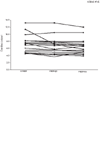Gastric intramucosal pH is stable during titration of positive end-expiratory pressure to improve oxygenation in acute respiratory distress syndrome
- PMID: 12793886
- PMCID: PMC270676
- DOI: 10.1186/cc2172
Gastric intramucosal pH is stable during titration of positive end-expiratory pressure to improve oxygenation in acute respiratory distress syndrome
Abstract
Background: Optimal positive end-expiratory pressure (PEEP) is an important component of adequate mechanical ventilation in acute lung injury and acute respiratory distress syndrome (ARDS). In the present study we tested the effect on gastric intramucosal pH of incremental increases in PEEP level (i.e. PEEP titration) to improve oxygenation in ARDS. Seventeen consecutive patients with ARDS, as defined by consensus criteria, were included in this clinical, prospective study. All patients were haemodynamically stable, and were not receiving vasopressors. From an initial level of 5 cmH2O, PEEP was titrated at 2 cmH2O increments until the partial arterial oxygen tension was 300 mmHg or greater, peak airway pressure was 45 cmH2O or greater, or mean arterial blood pressure decreased by 20% or more of the baseline value. Optimal PEEP was defined as the level of PEEP that achieved the best oxygenation. The maximum PEEP was the highest PEEP level reached during titration in each patient.
Results: Gastric mucosal pH was measured using gastric tonometry at all levels of PEEP. The thermodilution technique was used for measurement of cardiac index. Gastric mucosal pH was similar at baseline and at optimal PEEP levels, but it was slightly reduced at maximum PEEP. Cardiac index and oxygen delivery remained stable at all PEEP levels.
Conclusion: Incremental titration of PEEP based on improvement in oxygenation does not decrease gastric intramucosal perfusion when cardiac output is preserved in patients with ARDS.
Figures
Similar articles
-
Effects of positive end-expiratory pressure on gastric mucosal perfusion in acute respiratory distress syndrome.Crit Care. 2004 Oct;8(5):R306-11. doi: 10.1186/cc2905. Epub 2004 Jul 15. Crit Care. 2004. PMID: 15469573 Free PMC article.
-
Pulmonary acute respiratory distress syndrome: positive end-expiratory pressure titration needs stress index.J Surg Res. 2013 Nov;185(1):347-52. doi: 10.1016/j.jss.2013.05.012. Epub 2013 May 25. J Surg Res. 2013. PMID: 23731684 Clinical Trial.
-
Evaluation of a recruitment maneuver with positive inspiratory pressure and high PEEP in patients with severe ARDS.Acta Anaesthesiol Scand. 2004 Mar;48(3):287-93. doi: 10.1111/j.0001-5172.2004.0305.x. Acta Anaesthesiol Scand. 2004. PMID: 14982560
-
Is high PEEP ventilation strategy safe for acute respiratory distress syndrome after severe traumatic brain injury?Brain Inj. 2012;26(6):887-90. doi: 10.3109/02699052.2012.660514. Brain Inj. 2012. PMID: 22583180 Review.
-
Higher PEEP improves outcomes in ARDS patients with clinically objective positive oxygenation response to PEEP: a systematic review and meta-analysis.BMC Anesthesiol. 2018 Nov 17;18(1):172. doi: 10.1186/s12871-018-0631-4. BMC Anesthesiol. 2018. PMID: 30447683 Free PMC article.
Cited by
-
Changes of splanchnic perfusion after applying positive end expiratory pressure in patients with acute respiratory distress syndrome.Indian J Crit Care Med. 2009 Jan-Mar;13(1):12-6. doi: 10.4103/0972-5229.53109. Indian J Crit Care Med. 2009. Retraction in: Indian J Crit Care Med. 2012 Jul;16(3):135. PMID: 19881173 Free PMC article. Retracted.
-
Year in review in Critical Care, 2003 and 2004: respirology and critical care.Crit Care. 2005 Oct 5;9(5):517-22. doi: 10.1186/cc3764. Epub 2005 Jul 1. Crit Care. 2005. PMID: 16277741 Free PMC article. Review.
-
Exploring the lung-gut direction of the gut-lung axis in patients with ARDS.Crit Care. 2024 May 27;28(1):179. doi: 10.1186/s13054-024-04966-4. Crit Care. 2024. PMID: 38802959 Free PMC article. Review.
-
Effects of positive end-expiratory pressure on gastric mucosal perfusion in acute respiratory distress syndrome.Crit Care. 2004 Oct;8(5):R306-11. doi: 10.1186/cc2905. Epub 2004 Jul 15. Crit Care. 2004. PMID: 15469573 Free PMC article.
References
-
- Guyton AC, Lindsey AW, Abernathy B, Richardson T. Venous return at various right atrial pressure and the normal venous return curve. Am J Physiol. 1957;189:609–615. - PubMed
-
- Pastores SM, Katz DP, Kvetan V. Splanchnic ischemia and gut mucosal injury in sepsis and the multiple organ dysfunction syndrome. Am J Gastroenterol. 1996;91:1697–1710. - PubMed
-
- Mutlu GM, Mutlu EA, Factor P. GI complications in patients receiving mechanical ventilation. Chest. 2001;119:1222–1241. - PubMed
-
- Brienza N, Revelly JP, Ayuse T, Robotham JL. Effects of PEEP on liver arterial and venous blood flows. Am J Respir Crit Care Med. 1995;152:504–510. - PubMed
-
- Fujita Y. Effects of PEEP on splanchnic hemodynamics and blood volume. Acta Anaesthesiol Scand. 1993;37:427–431. - PubMed
Publication types
MeSH terms
LinkOut - more resources
Full Text Sources


